Morrison Supermarkets: Leadership, Management, and Operations Report
VerifiedAdded on 2021/02/19
|18
|4458
|116
Report
AI Summary
This report provides an in-depth analysis of leadership and management practices within Morrison Supermarkets. It begins with an overview of the company, its management structure, and a comparison between leadership and management roles. The report then delves into the roles of leaders and managers in different situational contexts, evaluating leadership and management approaches, and their impacts on the organization. Task 2 focuses on organizational operations, the roles and responsibilities of managers in various operational functions, operational management approaches, external factors influencing decision-making, and strategies for improving operational efficiencies, concluding with recommendations for the organization. The report uses Morrison Supermarkets as a case study to illustrate key concepts and theories of leadership and management.
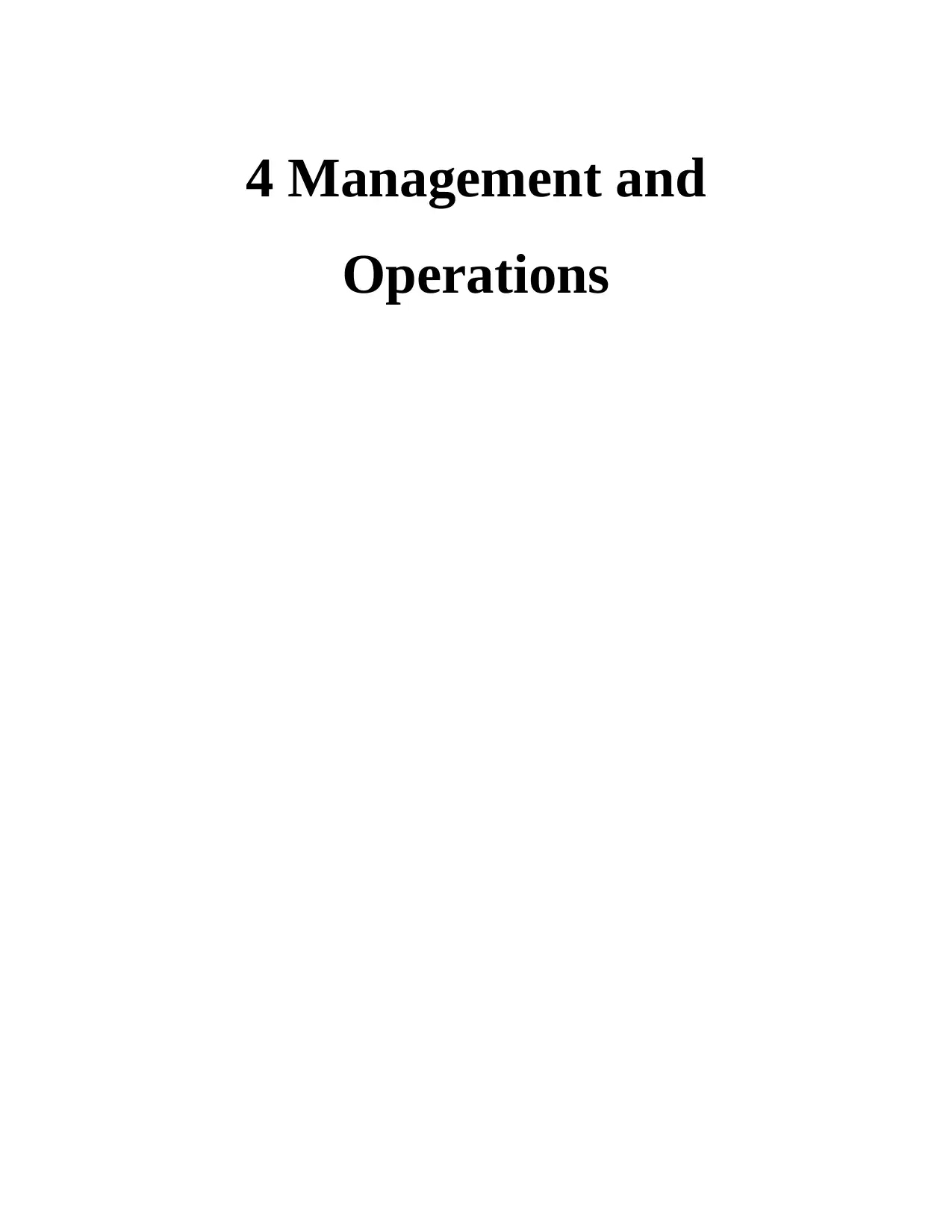
4 Management and
Operations
Operations
Paraphrase This Document
Need a fresh take? Get an instant paraphrase of this document with our AI Paraphraser
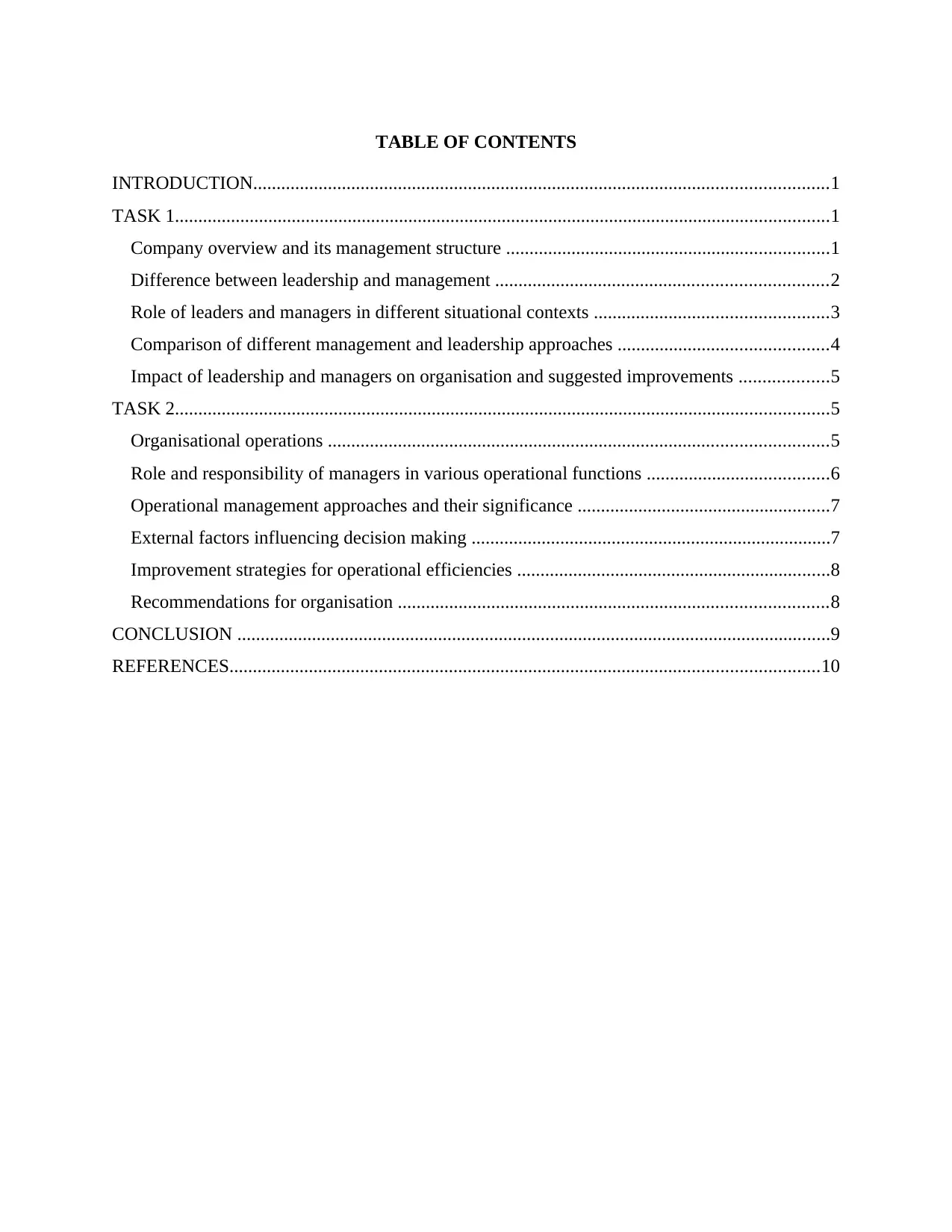
TABLE OF CONTENTS
INTRODUCTION...........................................................................................................................1
TASK 1............................................................................................................................................1
Company overview and its management structure .....................................................................1
Difference between leadership and management .......................................................................2
Role of leaders and managers in different situational contexts ..................................................3
Comparison of different management and leadership approaches .............................................4
Impact of leadership and managers on organisation and suggested improvements ...................5
TASK 2............................................................................................................................................5
Organisational operations ...........................................................................................................5
Role and responsibility of managers in various operational functions .......................................6
Operational management approaches and their significance ......................................................7
External factors influencing decision making .............................................................................7
Improvement strategies for operational efficiencies ...................................................................8
Recommendations for organisation ............................................................................................8
CONCLUSION ...............................................................................................................................9
REFERENCES..............................................................................................................................10
INTRODUCTION...........................................................................................................................1
TASK 1............................................................................................................................................1
Company overview and its management structure .....................................................................1
Difference between leadership and management .......................................................................2
Role of leaders and managers in different situational contexts ..................................................3
Comparison of different management and leadership approaches .............................................4
Impact of leadership and managers on organisation and suggested improvements ...................5
TASK 2............................................................................................................................................5
Organisational operations ...........................................................................................................5
Role and responsibility of managers in various operational functions .......................................6
Operational management approaches and their significance ......................................................7
External factors influencing decision making .............................................................................7
Improvement strategies for operational efficiencies ...................................................................8
Recommendations for organisation ............................................................................................8
CONCLUSION ...............................................................................................................................9
REFERENCES..............................................................................................................................10
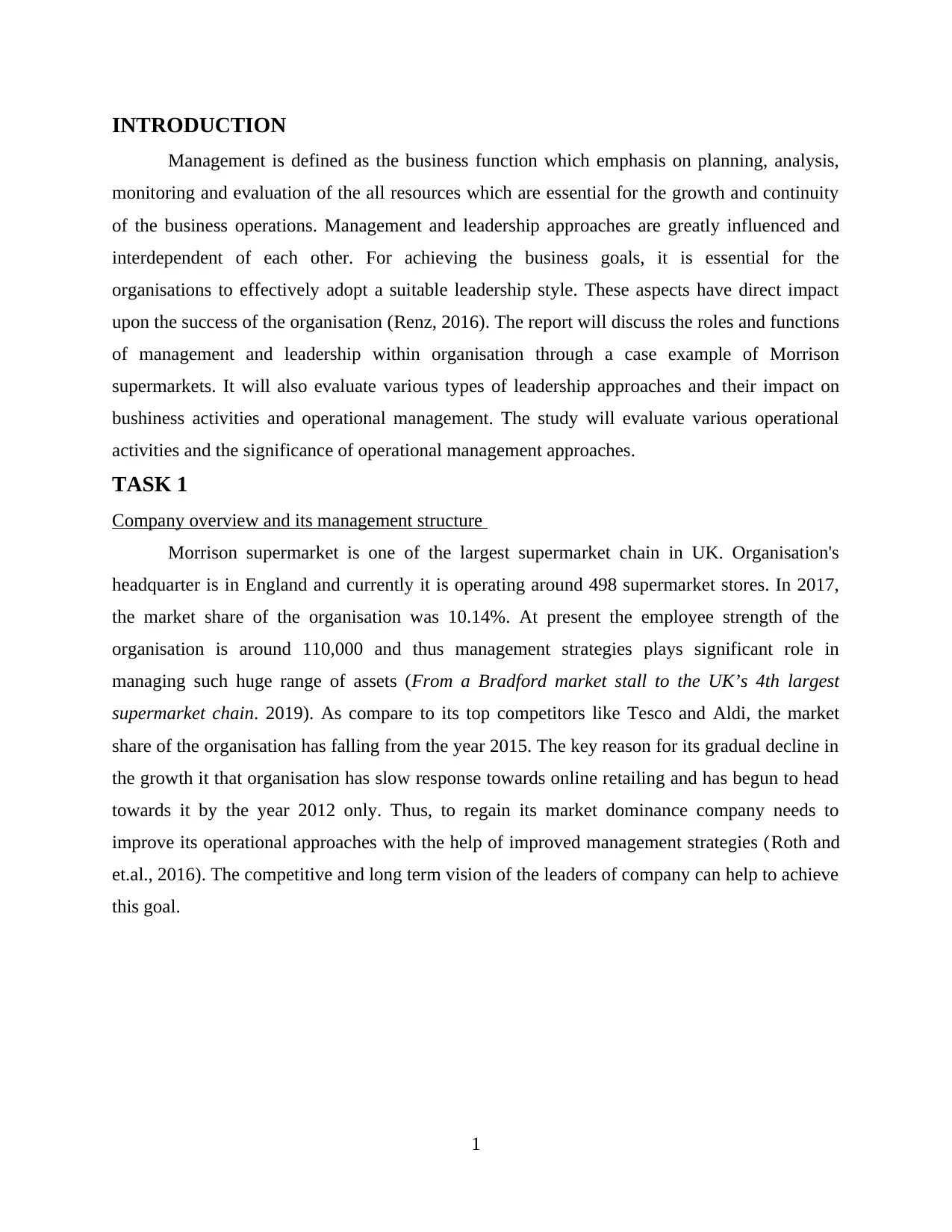
INTRODUCTION
Management is defined as the business function which emphasis on planning, analysis,
monitoring and evaluation of the all resources which are essential for the growth and continuity
of the business operations. Management and leadership approaches are greatly influenced and
interdependent of each other. For achieving the business goals, it is essential for the
organisations to effectively adopt a suitable leadership style. These aspects have direct impact
upon the success of the organisation (Renz, 2016). The report will discuss the roles and functions
of management and leadership within organisation through a case example of Morrison
supermarkets. It will also evaluate various types of leadership approaches and their impact on
bushiness activities and operational management. The study will evaluate various operational
activities and the significance of operational management approaches.
TASK 1
Company overview and its management structure
Morrison supermarket is one of the largest supermarket chain in UK. Organisation's
headquarter is in England and currently it is operating around 498 supermarket stores. In 2017,
the market share of the organisation was 10.14%. At present the employee strength of the
organisation is around 110,000 and thus management strategies plays significant role in
managing such huge range of assets (From a Bradford market stall to the UK’s 4th largest
supermarket chain. 2019). As compare to its top competitors like Tesco and Aldi, the market
share of the organisation has falling from the year 2015. The key reason for its gradual decline in
the growth it that organisation has slow response towards online retailing and has begun to head
towards it by the year 2012 only. Thus, to regain its market dominance company needs to
improve its operational approaches with the help of improved management strategies (Roth and
et.al., 2016). The competitive and long term vision of the leaders of company can help to achieve
this goal.
1
Management is defined as the business function which emphasis on planning, analysis,
monitoring and evaluation of the all resources which are essential for the growth and continuity
of the business operations. Management and leadership approaches are greatly influenced and
interdependent of each other. For achieving the business goals, it is essential for the
organisations to effectively adopt a suitable leadership style. These aspects have direct impact
upon the success of the organisation (Renz, 2016). The report will discuss the roles and functions
of management and leadership within organisation through a case example of Morrison
supermarkets. It will also evaluate various types of leadership approaches and their impact on
bushiness activities and operational management. The study will evaluate various operational
activities and the significance of operational management approaches.
TASK 1
Company overview and its management structure
Morrison supermarket is one of the largest supermarket chain in UK. Organisation's
headquarter is in England and currently it is operating around 498 supermarket stores. In 2017,
the market share of the organisation was 10.14%. At present the employee strength of the
organisation is around 110,000 and thus management strategies plays significant role in
managing such huge range of assets (From a Bradford market stall to the UK’s 4th largest
supermarket chain. 2019). As compare to its top competitors like Tesco and Aldi, the market
share of the organisation has falling from the year 2015. The key reason for its gradual decline in
the growth it that organisation has slow response towards online retailing and has begun to head
towards it by the year 2012 only. Thus, to regain its market dominance company needs to
improve its operational approaches with the help of improved management strategies (Roth and
et.al., 2016). The competitive and long term vision of the leaders of company can help to achieve
this goal.
1
⊘ This is a preview!⊘
Do you want full access?
Subscribe today to unlock all pages.

Trusted by 1+ million students worldwide
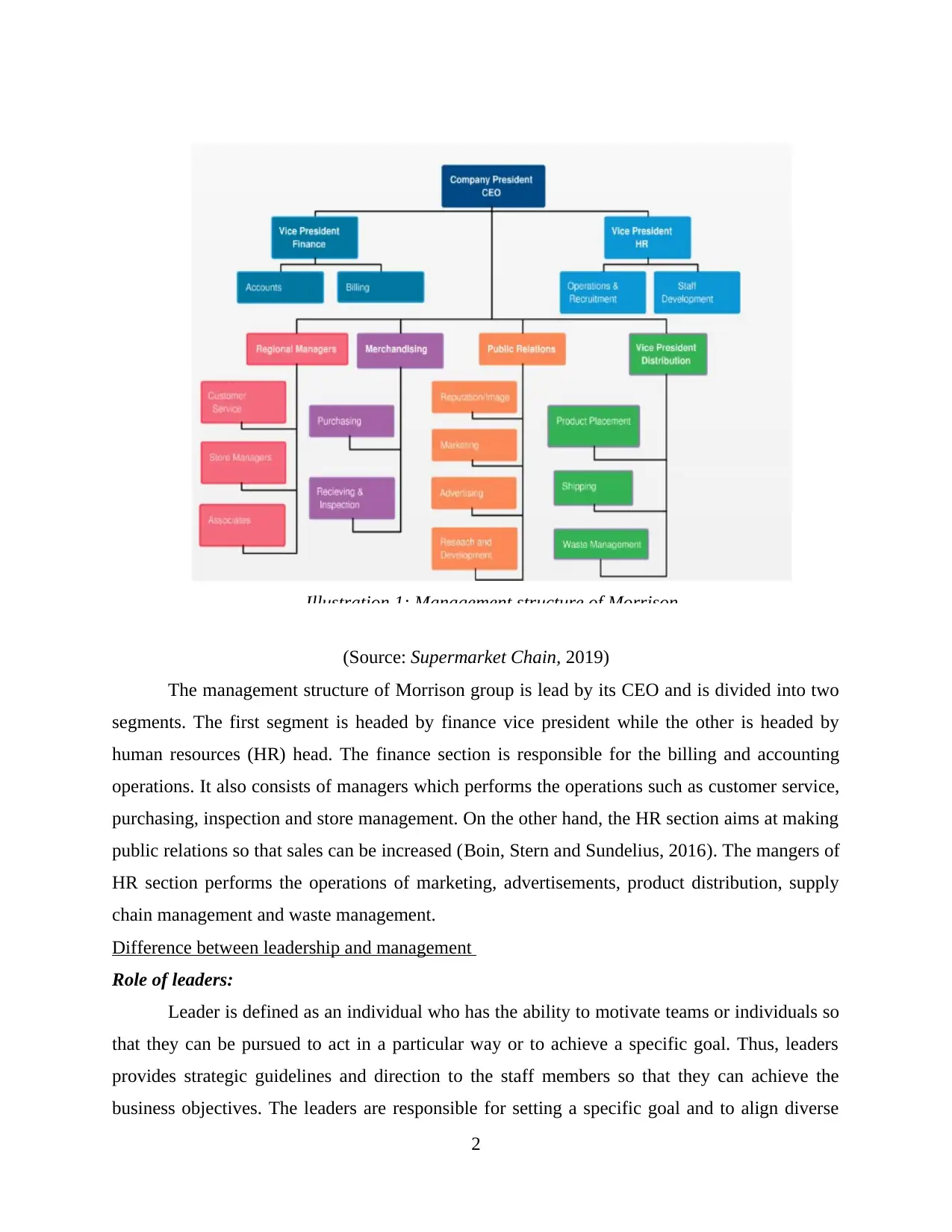
(Source: Supermarket Chain, 2019)
The management structure of Morrison group is lead by its CEO and is divided into two
segments. The first segment is headed by finance vice president while the other is headed by
human resources (HR) head. The finance section is responsible for the billing and accounting
operations. It also consists of managers which performs the operations such as customer service,
purchasing, inspection and store management. On the other hand, the HR section aims at making
public relations so that sales can be increased (Boin, Stern and Sundelius, 2016). The mangers of
HR section performs the operations of marketing, advertisements, product distribution, supply
chain management and waste management.
Difference between leadership and management
Role of leaders:
Leader is defined as an individual who has the ability to motivate teams or individuals so
that they can be pursued to act in a particular way or to achieve a specific goal. Thus, leaders
provides strategic guidelines and direction to the staff members so that they can achieve the
business objectives. The leaders are responsible for setting a specific goal and to align diverse
2
Illustration 1: Management structure of Morrison
The management structure of Morrison group is lead by its CEO and is divided into two
segments. The first segment is headed by finance vice president while the other is headed by
human resources (HR) head. The finance section is responsible for the billing and accounting
operations. It also consists of managers which performs the operations such as customer service,
purchasing, inspection and store management. On the other hand, the HR section aims at making
public relations so that sales can be increased (Boin, Stern and Sundelius, 2016). The mangers of
HR section performs the operations of marketing, advertisements, product distribution, supply
chain management and waste management.
Difference between leadership and management
Role of leaders:
Leader is defined as an individual who has the ability to motivate teams or individuals so
that they can be pursued to act in a particular way or to achieve a specific goal. Thus, leaders
provides strategic guidelines and direction to the staff members so that they can achieve the
business objectives. The leaders are responsible for setting a specific goal and to align diverse
2
Illustration 1: Management structure of Morrison
Paraphrase This Document
Need a fresh take? Get an instant paraphrase of this document with our AI Paraphraser
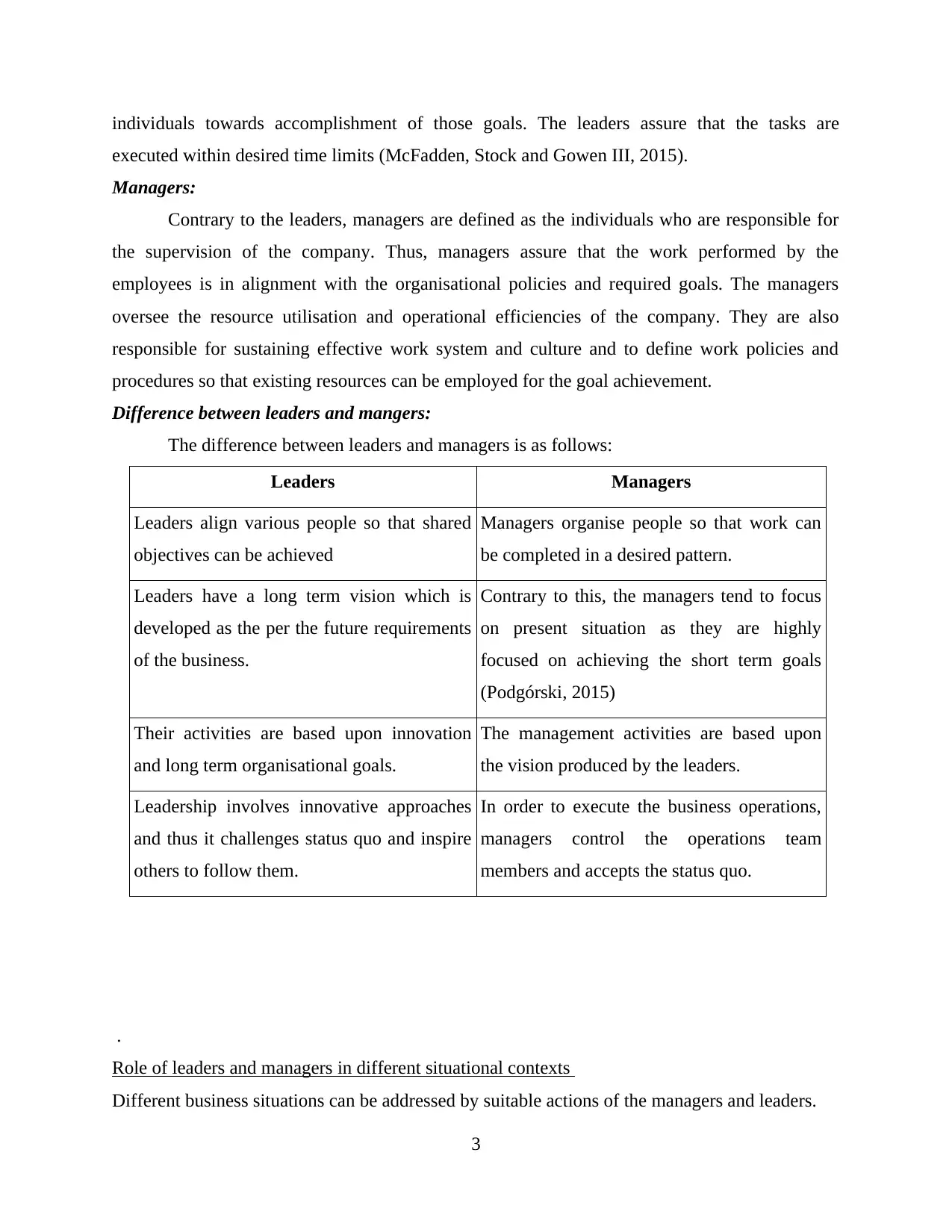
individuals towards accomplishment of those goals. The leaders assure that the tasks are
executed within desired time limits (McFadden, Stock and Gowen III, 2015).
Managers:
Contrary to the leaders, managers are defined as the individuals who are responsible for
the supervision of the company. Thus, managers assure that the work performed by the
employees is in alignment with the organisational policies and required goals. The managers
oversee the resource utilisation and operational efficiencies of the company. They are also
responsible for sustaining effective work system and culture and to define work policies and
procedures so that existing resources can be employed for the goal achievement.
Difference between leaders and mangers:
The difference between leaders and managers is as follows:
Leaders Managers
Leaders align various people so that shared
objectives can be achieved
Managers organise people so that work can
be completed in a desired pattern.
Leaders have a long term vision which is
developed as the per the future requirements
of the business.
Contrary to this, the managers tend to focus
on present situation as they are highly
focused on achieving the short term goals
(Podgórski, 2015)
Their activities are based upon innovation
and long term organisational goals.
The management activities are based upon
the vision produced by the leaders.
Leadership involves innovative approaches
and thus it challenges status quo and inspire
others to follow them.
In order to execute the business operations,
managers control the operations team
members and accepts the status quo.
.
Role of leaders and managers in different situational contexts
Different business situations can be addressed by suitable actions of the managers and leaders.
3
executed within desired time limits (McFadden, Stock and Gowen III, 2015).
Managers:
Contrary to the leaders, managers are defined as the individuals who are responsible for
the supervision of the company. Thus, managers assure that the work performed by the
employees is in alignment with the organisational policies and required goals. The managers
oversee the resource utilisation and operational efficiencies of the company. They are also
responsible for sustaining effective work system and culture and to define work policies and
procedures so that existing resources can be employed for the goal achievement.
Difference between leaders and mangers:
The difference between leaders and managers is as follows:
Leaders Managers
Leaders align various people so that shared
objectives can be achieved
Managers organise people so that work can
be completed in a desired pattern.
Leaders have a long term vision which is
developed as the per the future requirements
of the business.
Contrary to this, the managers tend to focus
on present situation as they are highly
focused on achieving the short term goals
(Podgórski, 2015)
Their activities are based upon innovation
and long term organisational goals.
The management activities are based upon
the vision produced by the leaders.
Leadership involves innovative approaches
and thus it challenges status quo and inspire
others to follow them.
In order to execute the business operations,
managers control the operations team
members and accepts the status quo.
.
Role of leaders and managers in different situational contexts
Different business situations can be addressed by suitable actions of the managers and leaders.
3
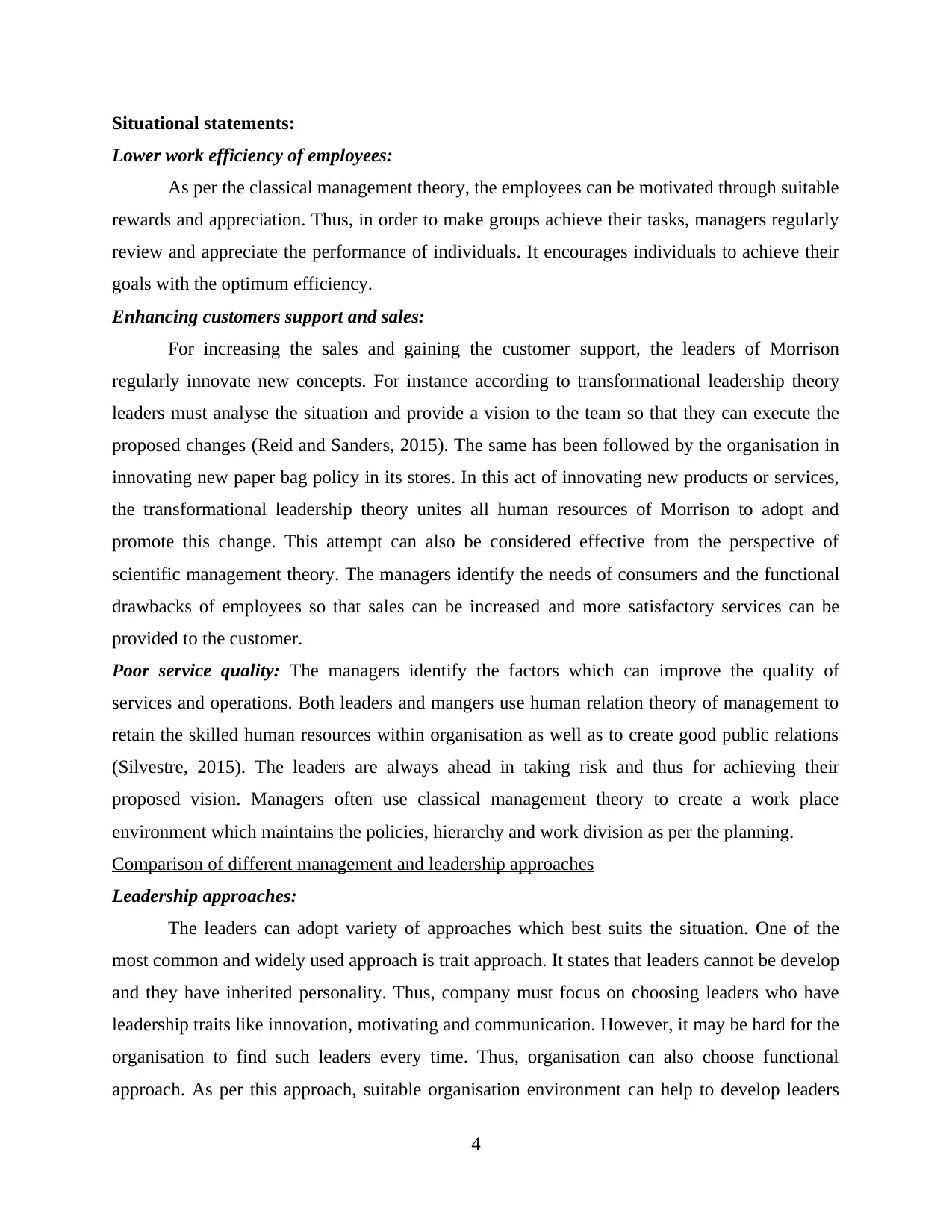
Situational statements:
Lower work efficiency of employees:
As per the classical management theory, the employees can be motivated through suitable
rewards and appreciation. Thus, in order to make groups achieve their tasks, managers regularly
review and appreciate the performance of individuals. It encourages individuals to achieve their
goals with the optimum efficiency.
Enhancing customers support and sales:
For increasing the sales and gaining the customer support, the leaders of Morrison
regularly innovate new concepts. For instance according to transformational leadership theory
leaders must analyse the situation and provide a vision to the team so that they can execute the
proposed changes (Reid and Sanders, 2015). The same has been followed by the organisation in
innovating new paper bag policy in its stores. In this act of innovating new products or services,
the transformational leadership theory unites all human resources of Morrison to adopt and
promote this change. This attempt can also be considered effective from the perspective of
scientific management theory. The managers identify the needs of consumers and the functional
drawbacks of employees so that sales can be increased and more satisfactory services can be
provided to the customer.
Poor service quality: The managers identify the factors which can improve the quality of
services and operations. Both leaders and mangers use human relation theory of management to
retain the skilled human resources within organisation as well as to create good public relations
(Silvestre, 2015). The leaders are always ahead in taking risk and thus for achieving their
proposed vision. Managers often use classical management theory to create a work place
environment which maintains the policies, hierarchy and work division as per the planning.
Comparison of different management and leadership approaches
Leadership approaches:
The leaders can adopt variety of approaches which best suits the situation. One of the
most common and widely used approach is trait approach. It states that leaders cannot be develop
and they have inherited personality. Thus, company must focus on choosing leaders who have
leadership traits like innovation, motivating and communication. However, it may be hard for the
organisation to find such leaders every time. Thus, organisation can also choose functional
approach. As per this approach, suitable organisation environment can help to develop leaders
4
Lower work efficiency of employees:
As per the classical management theory, the employees can be motivated through suitable
rewards and appreciation. Thus, in order to make groups achieve their tasks, managers regularly
review and appreciate the performance of individuals. It encourages individuals to achieve their
goals with the optimum efficiency.
Enhancing customers support and sales:
For increasing the sales and gaining the customer support, the leaders of Morrison
regularly innovate new concepts. For instance according to transformational leadership theory
leaders must analyse the situation and provide a vision to the team so that they can execute the
proposed changes (Reid and Sanders, 2015). The same has been followed by the organisation in
innovating new paper bag policy in its stores. In this act of innovating new products or services,
the transformational leadership theory unites all human resources of Morrison to adopt and
promote this change. This attempt can also be considered effective from the perspective of
scientific management theory. The managers identify the needs of consumers and the functional
drawbacks of employees so that sales can be increased and more satisfactory services can be
provided to the customer.
Poor service quality: The managers identify the factors which can improve the quality of
services and operations. Both leaders and mangers use human relation theory of management to
retain the skilled human resources within organisation as well as to create good public relations
(Silvestre, 2015). The leaders are always ahead in taking risk and thus for achieving their
proposed vision. Managers often use classical management theory to create a work place
environment which maintains the policies, hierarchy and work division as per the planning.
Comparison of different management and leadership approaches
Leadership approaches:
The leaders can adopt variety of approaches which best suits the situation. One of the
most common and widely used approach is trait approach. It states that leaders cannot be develop
and they have inherited personality. Thus, company must focus on choosing leaders who have
leadership traits like innovation, motivating and communication. However, it may be hard for the
organisation to find such leaders every time. Thus, organisation can also choose functional
approach. As per this approach, suitable organisation environment can help to develop leaders
4
⊘ This is a preview!⊘
Do you want full access?
Subscribe today to unlock all pages.

Trusted by 1+ million students worldwide
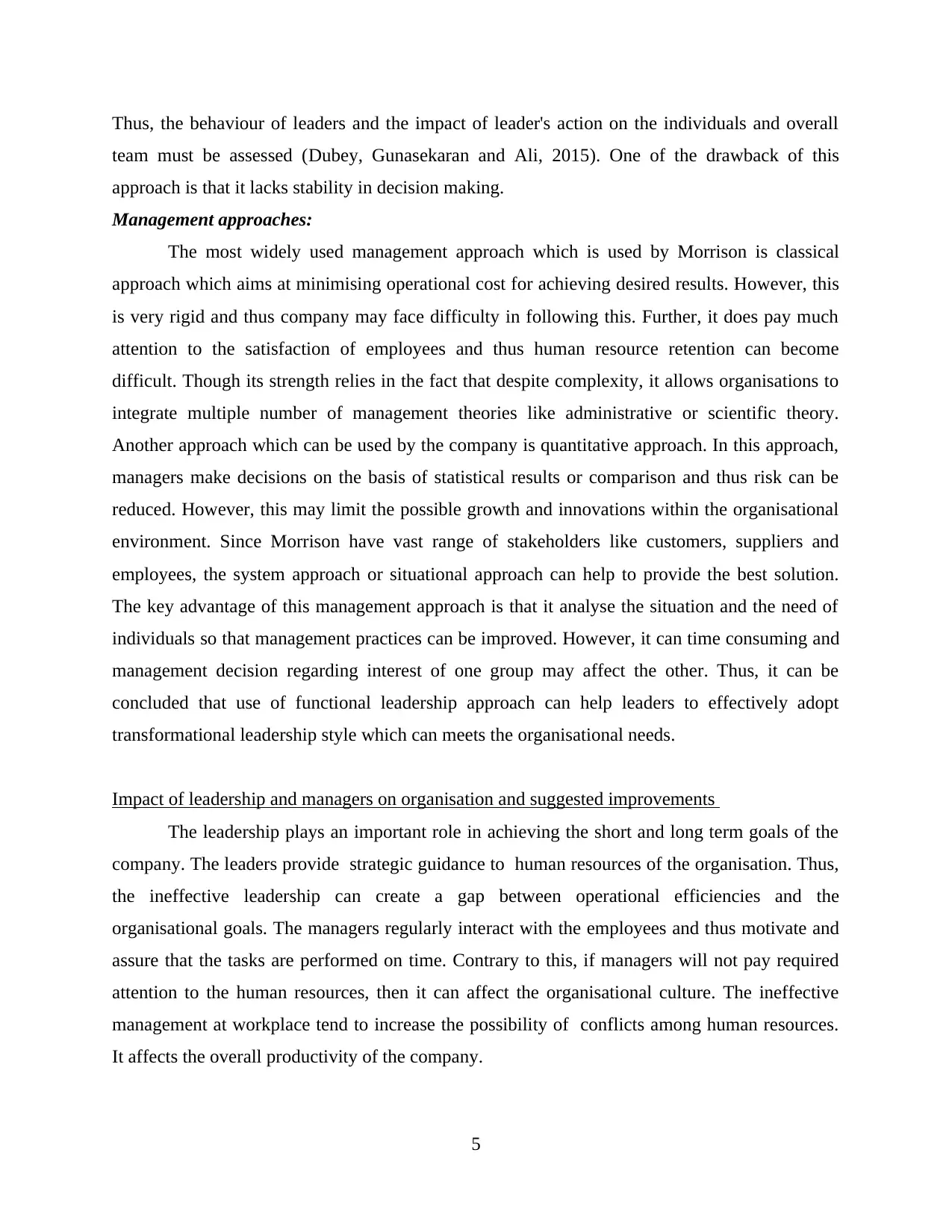
Thus, the behaviour of leaders and the impact of leader's action on the individuals and overall
team must be assessed (Dubey, Gunasekaran and Ali, 2015). One of the drawback of this
approach is that it lacks stability in decision making.
Management approaches:
The most widely used management approach which is used by Morrison is classical
approach which aims at minimising operational cost for achieving desired results. However, this
is very rigid and thus company may face difficulty in following this. Further, it does pay much
attention to the satisfaction of employees and thus human resource retention can become
difficult. Though its strength relies in the fact that despite complexity, it allows organisations to
integrate multiple number of management theories like administrative or scientific theory.
Another approach which can be used by the company is quantitative approach. In this approach,
managers make decisions on the basis of statistical results or comparison and thus risk can be
reduced. However, this may limit the possible growth and innovations within the organisational
environment. Since Morrison have vast range of stakeholders like customers, suppliers and
employees, the system approach or situational approach can help to provide the best solution.
The key advantage of this management approach is that it analyse the situation and the need of
individuals so that management practices can be improved. However, it can time consuming and
management decision regarding interest of one group may affect the other. Thus, it can be
concluded that use of functional leadership approach can help leaders to effectively adopt
transformational leadership style which can meets the organisational needs.
Impact of leadership and managers on organisation and suggested improvements
The leadership plays an important role in achieving the short and long term goals of the
company. The leaders provide strategic guidance to human resources of the organisation. Thus,
the ineffective leadership can create a gap between operational efficiencies and the
organisational goals. The managers regularly interact with the employees and thus motivate and
assure that the tasks are performed on time. Contrary to this, if managers will not pay required
attention to the human resources, then it can affect the organisational culture. The ineffective
management at workplace tend to increase the possibility of conflicts among human resources.
It affects the overall productivity of the company.
5
team must be assessed (Dubey, Gunasekaran and Ali, 2015). One of the drawback of this
approach is that it lacks stability in decision making.
Management approaches:
The most widely used management approach which is used by Morrison is classical
approach which aims at minimising operational cost for achieving desired results. However, this
is very rigid and thus company may face difficulty in following this. Further, it does pay much
attention to the satisfaction of employees and thus human resource retention can become
difficult. Though its strength relies in the fact that despite complexity, it allows organisations to
integrate multiple number of management theories like administrative or scientific theory.
Another approach which can be used by the company is quantitative approach. In this approach,
managers make decisions on the basis of statistical results or comparison and thus risk can be
reduced. However, this may limit the possible growth and innovations within the organisational
environment. Since Morrison have vast range of stakeholders like customers, suppliers and
employees, the system approach or situational approach can help to provide the best solution.
The key advantage of this management approach is that it analyse the situation and the need of
individuals so that management practices can be improved. However, it can time consuming and
management decision regarding interest of one group may affect the other. Thus, it can be
concluded that use of functional leadership approach can help leaders to effectively adopt
transformational leadership style which can meets the organisational needs.
Impact of leadership and managers on organisation and suggested improvements
The leadership plays an important role in achieving the short and long term goals of the
company. The leaders provide strategic guidance to human resources of the organisation. Thus,
the ineffective leadership can create a gap between operational efficiencies and the
organisational goals. The managers regularly interact with the employees and thus motivate and
assure that the tasks are performed on time. Contrary to this, if managers will not pay required
attention to the human resources, then it can affect the organisational culture. The ineffective
management at workplace tend to increase the possibility of conflicts among human resources.
It affects the overall productivity of the company.
5
Paraphrase This Document
Need a fresh take? Get an instant paraphrase of this document with our AI Paraphraser
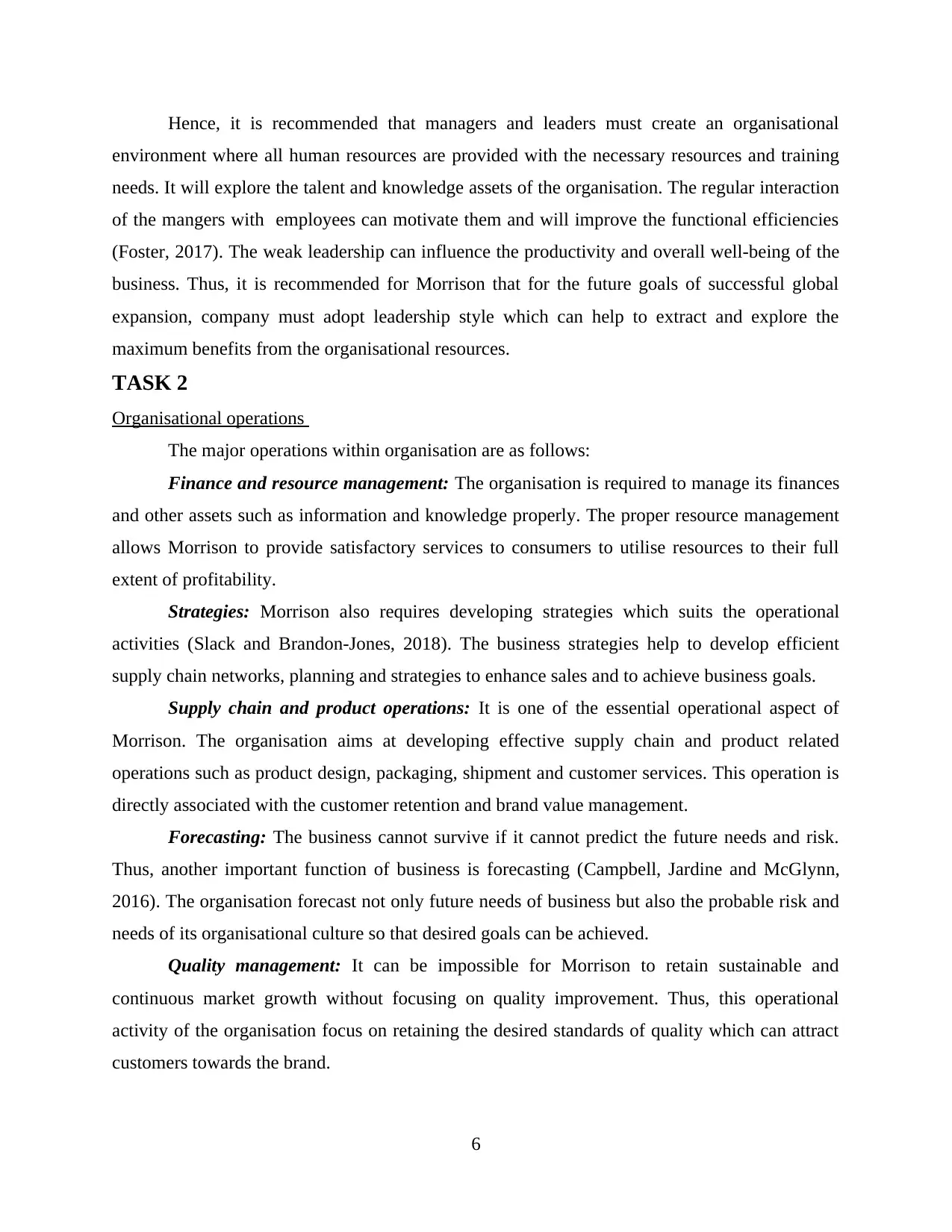
Hence, it is recommended that managers and leaders must create an organisational
environment where all human resources are provided with the necessary resources and training
needs. It will explore the talent and knowledge assets of the organisation. The regular interaction
of the mangers with employees can motivate them and will improve the functional efficiencies
(Foster, 2017). The weak leadership can influence the productivity and overall well-being of the
business. Thus, it is recommended for Morrison that for the future goals of successful global
expansion, company must adopt leadership style which can help to extract and explore the
maximum benefits from the organisational resources.
TASK 2
Organisational operations
The major operations within organisation are as follows:
Finance and resource management: The organisation is required to manage its finances
and other assets such as information and knowledge properly. The proper resource management
allows Morrison to provide satisfactory services to consumers to utilise resources to their full
extent of profitability.
Strategies: Morrison also requires developing strategies which suits the operational
activities (Slack and Brandon-Jones, 2018). The business strategies help to develop efficient
supply chain networks, planning and strategies to enhance sales and to achieve business goals.
Supply chain and product operations: It is one of the essential operational aspect of
Morrison. The organisation aims at developing effective supply chain and product related
operations such as product design, packaging, shipment and customer services. This operation is
directly associated with the customer retention and brand value management.
Forecasting: The business cannot survive if it cannot predict the future needs and risk.
Thus, another important function of business is forecasting (Campbell, Jardine and McGlynn,
2016). The organisation forecast not only future needs of business but also the probable risk and
needs of its organisational culture so that desired goals can be achieved.
Quality management: It can be impossible for Morrison to retain sustainable and
continuous market growth without focusing on quality improvement. Thus, this operational
activity of the organisation focus on retaining the desired standards of quality which can attract
customers towards the brand.
6
environment where all human resources are provided with the necessary resources and training
needs. It will explore the talent and knowledge assets of the organisation. The regular interaction
of the mangers with employees can motivate them and will improve the functional efficiencies
(Foster, 2017). The weak leadership can influence the productivity and overall well-being of the
business. Thus, it is recommended for Morrison that for the future goals of successful global
expansion, company must adopt leadership style which can help to extract and explore the
maximum benefits from the organisational resources.
TASK 2
Organisational operations
The major operations within organisation are as follows:
Finance and resource management: The organisation is required to manage its finances
and other assets such as information and knowledge properly. The proper resource management
allows Morrison to provide satisfactory services to consumers to utilise resources to their full
extent of profitability.
Strategies: Morrison also requires developing strategies which suits the operational
activities (Slack and Brandon-Jones, 2018). The business strategies help to develop efficient
supply chain networks, planning and strategies to enhance sales and to achieve business goals.
Supply chain and product operations: It is one of the essential operational aspect of
Morrison. The organisation aims at developing effective supply chain and product related
operations such as product design, packaging, shipment and customer services. This operation is
directly associated with the customer retention and brand value management.
Forecasting: The business cannot survive if it cannot predict the future needs and risk.
Thus, another important function of business is forecasting (Campbell, Jardine and McGlynn,
2016). The organisation forecast not only future needs of business but also the probable risk and
needs of its organisational culture so that desired goals can be achieved.
Quality management: It can be impossible for Morrison to retain sustainable and
continuous market growth without focusing on quality improvement. Thus, this operational
activity of the organisation focus on retaining the desired standards of quality which can attract
customers towards the brand.
6
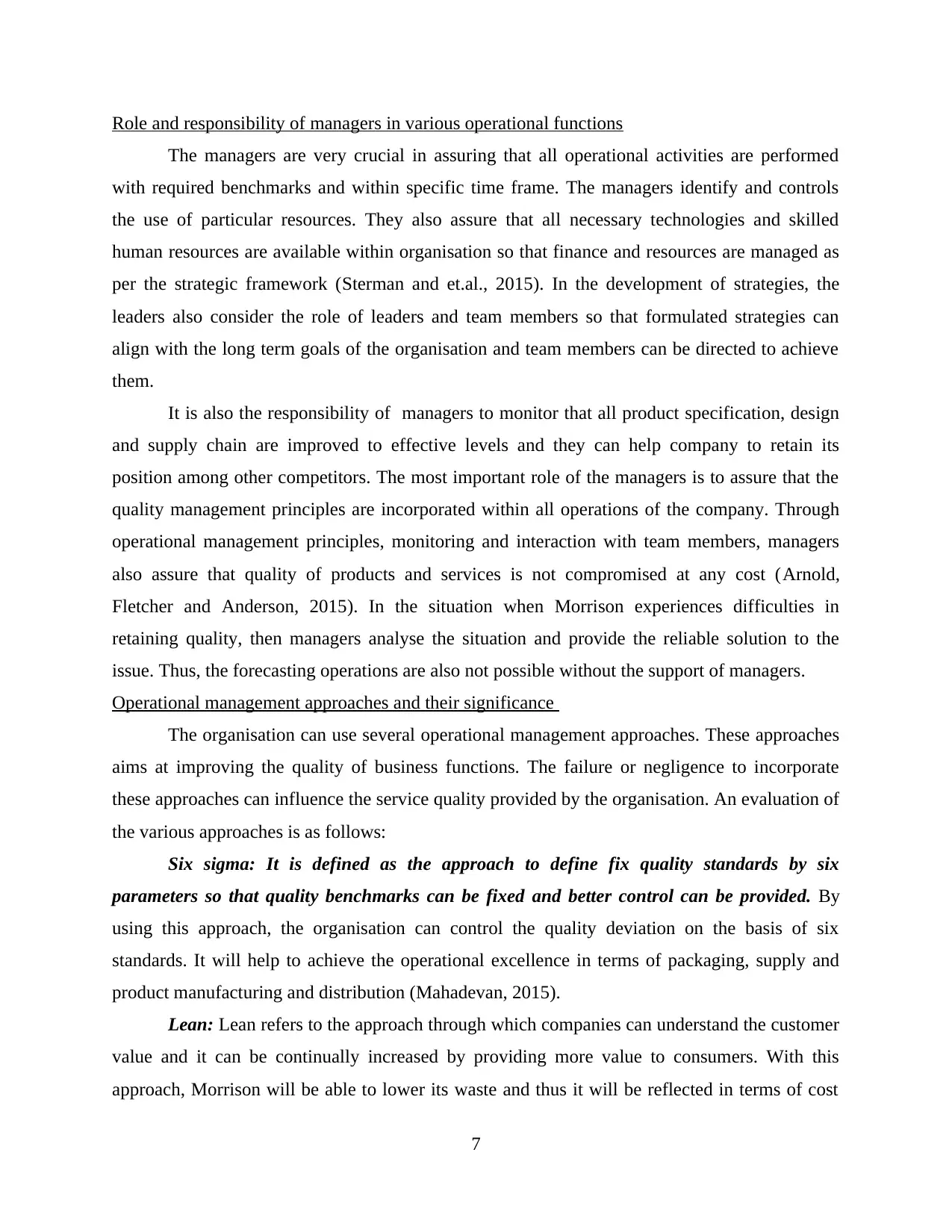
Role and responsibility of managers in various operational functions
The managers are very crucial in assuring that all operational activities are performed
with required benchmarks and within specific time frame. The managers identify and controls
the use of particular resources. They also assure that all necessary technologies and skilled
human resources are available within organisation so that finance and resources are managed as
per the strategic framework (Sterman and et.al., 2015). In the development of strategies, the
leaders also consider the role of leaders and team members so that formulated strategies can
align with the long term goals of the organisation and team members can be directed to achieve
them.
It is also the responsibility of managers to monitor that all product specification, design
and supply chain are improved to effective levels and they can help company to retain its
position among other competitors. The most important role of the managers is to assure that the
quality management principles are incorporated within all operations of the company. Through
operational management principles, monitoring and interaction with team members, managers
also assure that quality of products and services is not compromised at any cost (Arnold,
Fletcher and Anderson, 2015). In the situation when Morrison experiences difficulties in
retaining quality, then managers analyse the situation and provide the reliable solution to the
issue. Thus, the forecasting operations are also not possible without the support of managers.
Operational management approaches and their significance
The organisation can use several operational management approaches. These approaches
aims at improving the quality of business functions. The failure or negligence to incorporate
these approaches can influence the service quality provided by the organisation. An evaluation of
the various approaches is as follows:
Six sigma: It is defined as the approach to define fix quality standards by six
parameters so that quality benchmarks can be fixed and better control can be provided. By
using this approach, the organisation can control the quality deviation on the basis of six
standards. It will help to achieve the operational excellence in terms of packaging, supply and
product manufacturing and distribution (Mahadevan, 2015).
Lean: Lean refers to the approach through which companies can understand the customer
value and it can be continually increased by providing more value to consumers. With this
approach, Morrison will be able to lower its waste and thus it will be reflected in terms of cost
7
The managers are very crucial in assuring that all operational activities are performed
with required benchmarks and within specific time frame. The managers identify and controls
the use of particular resources. They also assure that all necessary technologies and skilled
human resources are available within organisation so that finance and resources are managed as
per the strategic framework (Sterman and et.al., 2015). In the development of strategies, the
leaders also consider the role of leaders and team members so that formulated strategies can
align with the long term goals of the organisation and team members can be directed to achieve
them.
It is also the responsibility of managers to monitor that all product specification, design
and supply chain are improved to effective levels and they can help company to retain its
position among other competitors. The most important role of the managers is to assure that the
quality management principles are incorporated within all operations of the company. Through
operational management principles, monitoring and interaction with team members, managers
also assure that quality of products and services is not compromised at any cost (Arnold,
Fletcher and Anderson, 2015). In the situation when Morrison experiences difficulties in
retaining quality, then managers analyse the situation and provide the reliable solution to the
issue. Thus, the forecasting operations are also not possible without the support of managers.
Operational management approaches and their significance
The organisation can use several operational management approaches. These approaches
aims at improving the quality of business functions. The failure or negligence to incorporate
these approaches can influence the service quality provided by the organisation. An evaluation of
the various approaches is as follows:
Six sigma: It is defined as the approach to define fix quality standards by six
parameters so that quality benchmarks can be fixed and better control can be provided. By
using this approach, the organisation can control the quality deviation on the basis of six
standards. It will help to achieve the operational excellence in terms of packaging, supply and
product manufacturing and distribution (Mahadevan, 2015).
Lean: Lean refers to the approach through which companies can understand the customer
value and it can be continually increased by providing more value to consumers. With this
approach, Morrison will be able to lower its waste and thus it will be reflected in terms of cost
7
⊘ This is a preview!⊘
Do you want full access?
Subscribe today to unlock all pages.

Trusted by 1+ million students worldwide
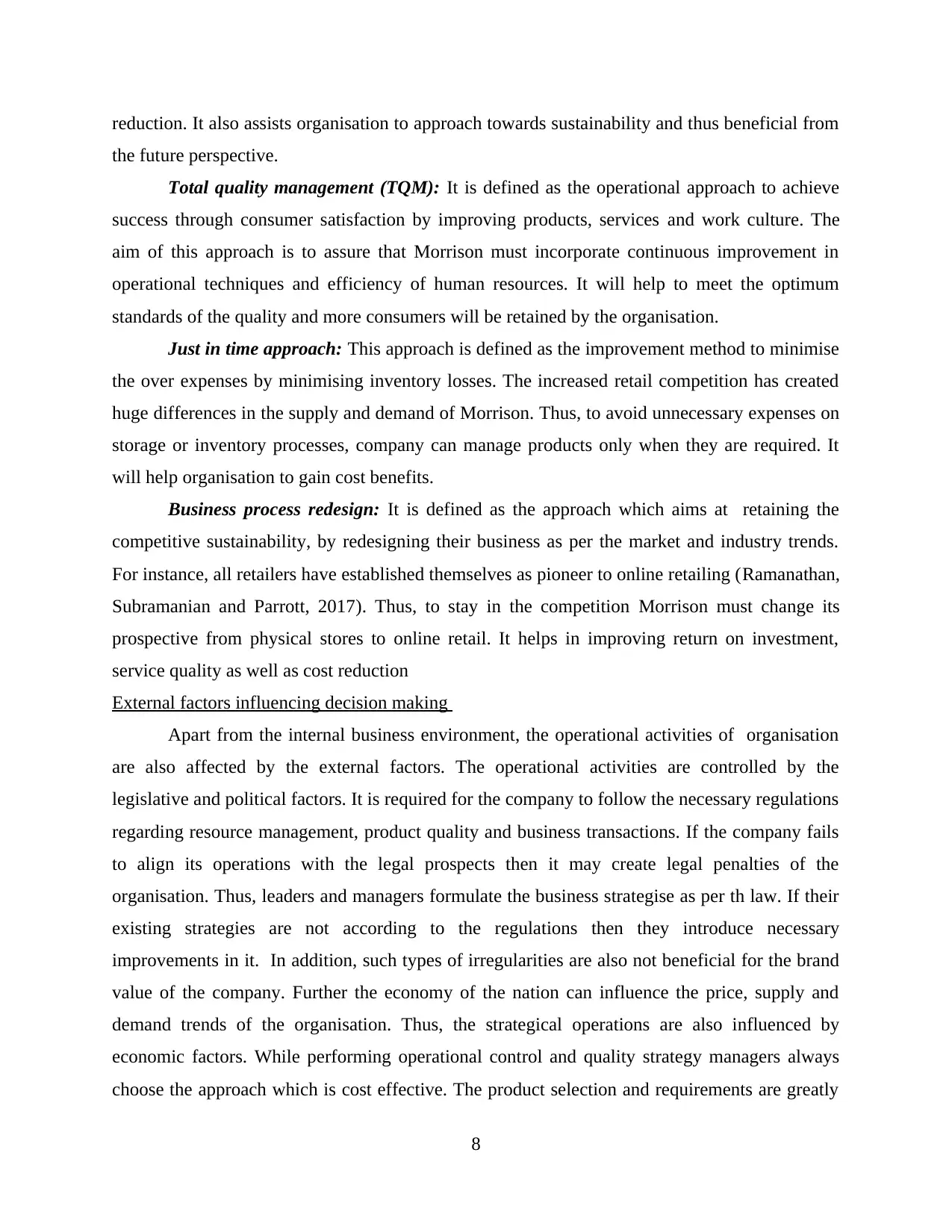
reduction. It also assists organisation to approach towards sustainability and thus beneficial from
the future perspective.
Total quality management (TQM): It is defined as the operational approach to achieve
success through consumer satisfaction by improving products, services and work culture. The
aim of this approach is to assure that Morrison must incorporate continuous improvement in
operational techniques and efficiency of human resources. It will help to meet the optimum
standards of the quality and more consumers will be retained by the organisation.
Just in time approach: This approach is defined as the improvement method to minimise
the over expenses by minimising inventory losses. The increased retail competition has created
huge differences in the supply and demand of Morrison. Thus, to avoid unnecessary expenses on
storage or inventory processes, company can manage products only when they are required. It
will help organisation to gain cost benefits.
Business process redesign: It is defined as the approach which aims at retaining the
competitive sustainability, by redesigning their business as per the market and industry trends.
For instance, all retailers have established themselves as pioneer to online retailing (Ramanathan,
Subramanian and Parrott, 2017). Thus, to stay in the competition Morrison must change its
prospective from physical stores to online retail. It helps in improving return on investment,
service quality as well as cost reduction
External factors influencing decision making
Apart from the internal business environment, the operational activities of organisation
are also affected by the external factors. The operational activities are controlled by the
legislative and political factors. It is required for the company to follow the necessary regulations
regarding resource management, product quality and business transactions. If the company fails
to align its operations with the legal prospects then it may create legal penalties of the
organisation. Thus, leaders and managers formulate the business strategise as per th law. If their
existing strategies are not according to the regulations then they introduce necessary
improvements in it. In addition, such types of irregularities are also not beneficial for the brand
value of the company. Further the economy of the nation can influence the price, supply and
demand trends of the organisation. Thus, the strategical operations are also influenced by
economic factors. While performing operational control and quality strategy managers always
choose the approach which is cost effective. The product selection and requirements are greatly
8
the future perspective.
Total quality management (TQM): It is defined as the operational approach to achieve
success through consumer satisfaction by improving products, services and work culture. The
aim of this approach is to assure that Morrison must incorporate continuous improvement in
operational techniques and efficiency of human resources. It will help to meet the optimum
standards of the quality and more consumers will be retained by the organisation.
Just in time approach: This approach is defined as the improvement method to minimise
the over expenses by minimising inventory losses. The increased retail competition has created
huge differences in the supply and demand of Morrison. Thus, to avoid unnecessary expenses on
storage or inventory processes, company can manage products only when they are required. It
will help organisation to gain cost benefits.
Business process redesign: It is defined as the approach which aims at retaining the
competitive sustainability, by redesigning their business as per the market and industry trends.
For instance, all retailers have established themselves as pioneer to online retailing (Ramanathan,
Subramanian and Parrott, 2017). Thus, to stay in the competition Morrison must change its
prospective from physical stores to online retail. It helps in improving return on investment,
service quality as well as cost reduction
External factors influencing decision making
Apart from the internal business environment, the operational activities of organisation
are also affected by the external factors. The operational activities are controlled by the
legislative and political factors. It is required for the company to follow the necessary regulations
regarding resource management, product quality and business transactions. If the company fails
to align its operations with the legal prospects then it may create legal penalties of the
organisation. Thus, leaders and managers formulate the business strategise as per th law. If their
existing strategies are not according to the regulations then they introduce necessary
improvements in it. In addition, such types of irregularities are also not beneficial for the brand
value of the company. Further the economy of the nation can influence the price, supply and
demand trends of the organisation. Thus, the strategical operations are also influenced by
economic factors. While performing operational control and quality strategy managers always
choose the approach which is cost effective. The product selection and requirements are greatly
8
Paraphrase This Document
Need a fresh take? Get an instant paraphrase of this document with our AI Paraphraser
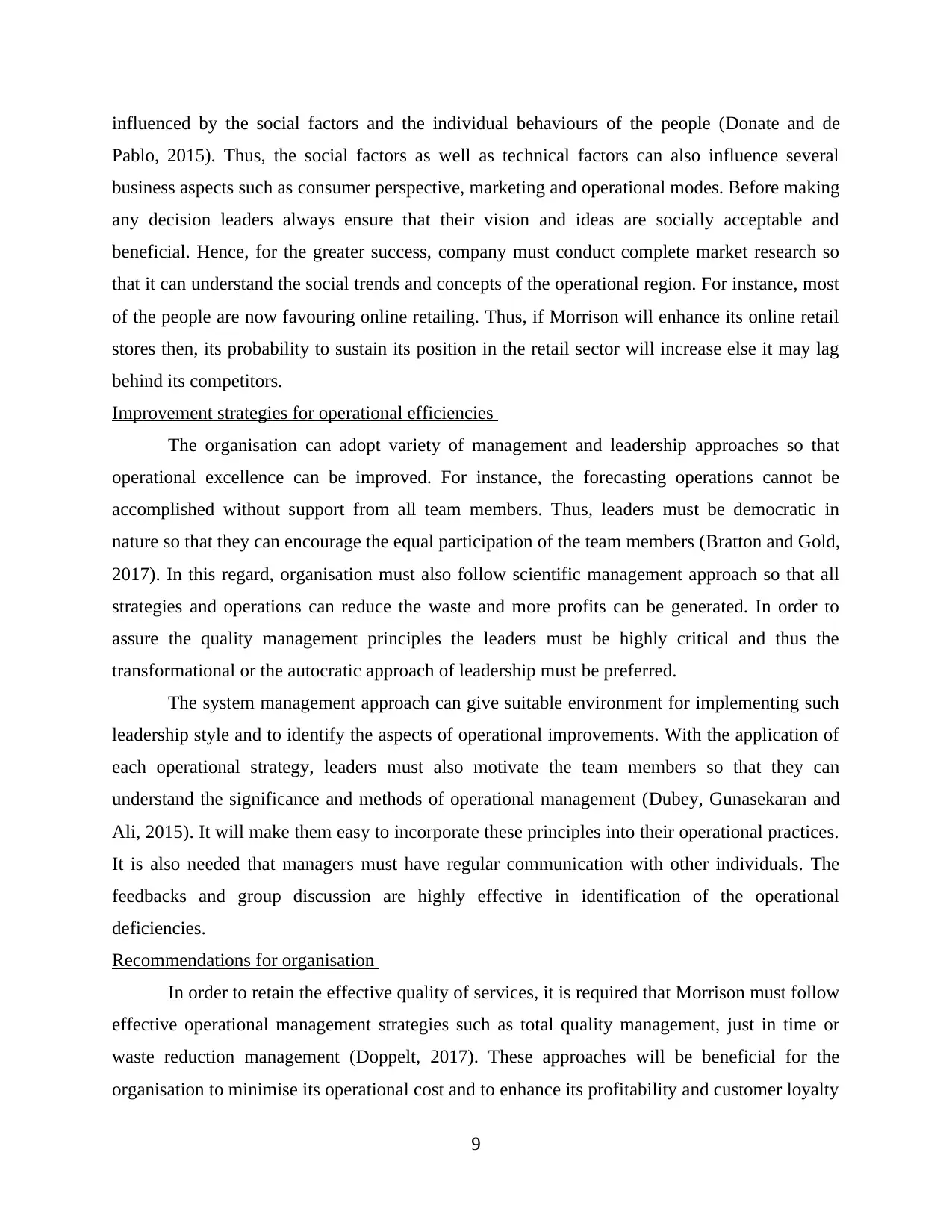
influenced by the social factors and the individual behaviours of the people (Donate and de
Pablo, 2015). Thus, the social factors as well as technical factors can also influence several
business aspects such as consumer perspective, marketing and operational modes. Before making
any decision leaders always ensure that their vision and ideas are socially acceptable and
beneficial. Hence, for the greater success, company must conduct complete market research so
that it can understand the social trends and concepts of the operational region. For instance, most
of the people are now favouring online retailing. Thus, if Morrison will enhance its online retail
stores then, its probability to sustain its position in the retail sector will increase else it may lag
behind its competitors.
Improvement strategies for operational efficiencies
The organisation can adopt variety of management and leadership approaches so that
operational excellence can be improved. For instance, the forecasting operations cannot be
accomplished without support from all team members. Thus, leaders must be democratic in
nature so that they can encourage the equal participation of the team members (Bratton and Gold,
2017). In this regard, organisation must also follow scientific management approach so that all
strategies and operations can reduce the waste and more profits can be generated. In order to
assure the quality management principles the leaders must be highly critical and thus the
transformational or the autocratic approach of leadership must be preferred.
The system management approach can give suitable environment for implementing such
leadership style and to identify the aspects of operational improvements. With the application of
each operational strategy, leaders must also motivate the team members so that they can
understand the significance and methods of operational management (Dubey, Gunasekaran and
Ali, 2015). It will make them easy to incorporate these principles into their operational practices.
It is also needed that managers must have regular communication with other individuals. The
feedbacks and group discussion are highly effective in identification of the operational
deficiencies.
Recommendations for organisation
In order to retain the effective quality of services, it is required that Morrison must follow
effective operational management strategies such as total quality management, just in time or
waste reduction management (Doppelt, 2017). These approaches will be beneficial for the
organisation to minimise its operational cost and to enhance its profitability and customer loyalty
9
Pablo, 2015). Thus, the social factors as well as technical factors can also influence several
business aspects such as consumer perspective, marketing and operational modes. Before making
any decision leaders always ensure that their vision and ideas are socially acceptable and
beneficial. Hence, for the greater success, company must conduct complete market research so
that it can understand the social trends and concepts of the operational region. For instance, most
of the people are now favouring online retailing. Thus, if Morrison will enhance its online retail
stores then, its probability to sustain its position in the retail sector will increase else it may lag
behind its competitors.
Improvement strategies for operational efficiencies
The organisation can adopt variety of management and leadership approaches so that
operational excellence can be improved. For instance, the forecasting operations cannot be
accomplished without support from all team members. Thus, leaders must be democratic in
nature so that they can encourage the equal participation of the team members (Bratton and Gold,
2017). In this regard, organisation must also follow scientific management approach so that all
strategies and operations can reduce the waste and more profits can be generated. In order to
assure the quality management principles the leaders must be highly critical and thus the
transformational or the autocratic approach of leadership must be preferred.
The system management approach can give suitable environment for implementing such
leadership style and to identify the aspects of operational improvements. With the application of
each operational strategy, leaders must also motivate the team members so that they can
understand the significance and methods of operational management (Dubey, Gunasekaran and
Ali, 2015). It will make them easy to incorporate these principles into their operational practices.
It is also needed that managers must have regular communication with other individuals. The
feedbacks and group discussion are highly effective in identification of the operational
deficiencies.
Recommendations for organisation
In order to retain the effective quality of services, it is required that Morrison must follow
effective operational management strategies such as total quality management, just in time or
waste reduction management (Doppelt, 2017). These approaches will be beneficial for the
organisation to minimise its operational cost and to enhance its profitability and customer loyalty
9
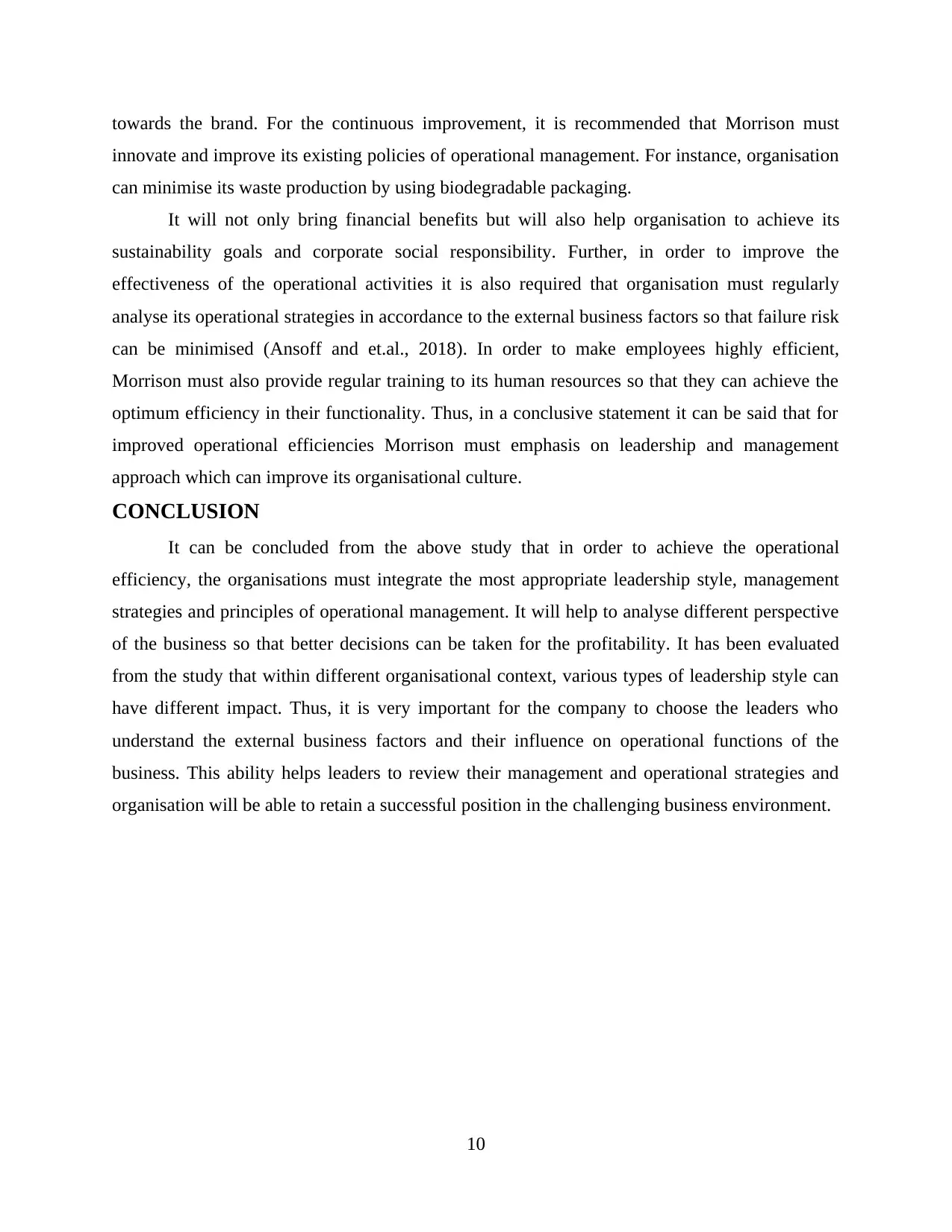
towards the brand. For the continuous improvement, it is recommended that Morrison must
innovate and improve its existing policies of operational management. For instance, organisation
can minimise its waste production by using biodegradable packaging.
It will not only bring financial benefits but will also help organisation to achieve its
sustainability goals and corporate social responsibility. Further, in order to improve the
effectiveness of the operational activities it is also required that organisation must regularly
analyse its operational strategies in accordance to the external business factors so that failure risk
can be minimised (Ansoff and et.al., 2018). In order to make employees highly efficient,
Morrison must also provide regular training to its human resources so that they can achieve the
optimum efficiency in their functionality. Thus, in a conclusive statement it can be said that for
improved operational efficiencies Morrison must emphasis on leadership and management
approach which can improve its organisational culture.
CONCLUSION
It can be concluded from the above study that in order to achieve the operational
efficiency, the organisations must integrate the most appropriate leadership style, management
strategies and principles of operational management. It will help to analyse different perspective
of the business so that better decisions can be taken for the profitability. It has been evaluated
from the study that within different organisational context, various types of leadership style can
have different impact. Thus, it is very important for the company to choose the leaders who
understand the external business factors and their influence on operational functions of the
business. This ability helps leaders to review their management and operational strategies and
organisation will be able to retain a successful position in the challenging business environment.
10
innovate and improve its existing policies of operational management. For instance, organisation
can minimise its waste production by using biodegradable packaging.
It will not only bring financial benefits but will also help organisation to achieve its
sustainability goals and corporate social responsibility. Further, in order to improve the
effectiveness of the operational activities it is also required that organisation must regularly
analyse its operational strategies in accordance to the external business factors so that failure risk
can be minimised (Ansoff and et.al., 2018). In order to make employees highly efficient,
Morrison must also provide regular training to its human resources so that they can achieve the
optimum efficiency in their functionality. Thus, in a conclusive statement it can be said that for
improved operational efficiencies Morrison must emphasis on leadership and management
approach which can improve its organisational culture.
CONCLUSION
It can be concluded from the above study that in order to achieve the operational
efficiency, the organisations must integrate the most appropriate leadership style, management
strategies and principles of operational management. It will help to analyse different perspective
of the business so that better decisions can be taken for the profitability. It has been evaluated
from the study that within different organisational context, various types of leadership style can
have different impact. Thus, it is very important for the company to choose the leaders who
understand the external business factors and their influence on operational functions of the
business. This ability helps leaders to review their management and operational strategies and
organisation will be able to retain a successful position in the challenging business environment.
10
⊘ This is a preview!⊘
Do you want full access?
Subscribe today to unlock all pages.

Trusted by 1+ million students worldwide
1 out of 18
Related Documents
Your All-in-One AI-Powered Toolkit for Academic Success.
+13062052269
info@desklib.com
Available 24*7 on WhatsApp / Email
![[object Object]](/_next/static/media/star-bottom.7253800d.svg)
Unlock your academic potential
Copyright © 2020–2025 A2Z Services. All Rights Reserved. Developed and managed by ZUCOL.





